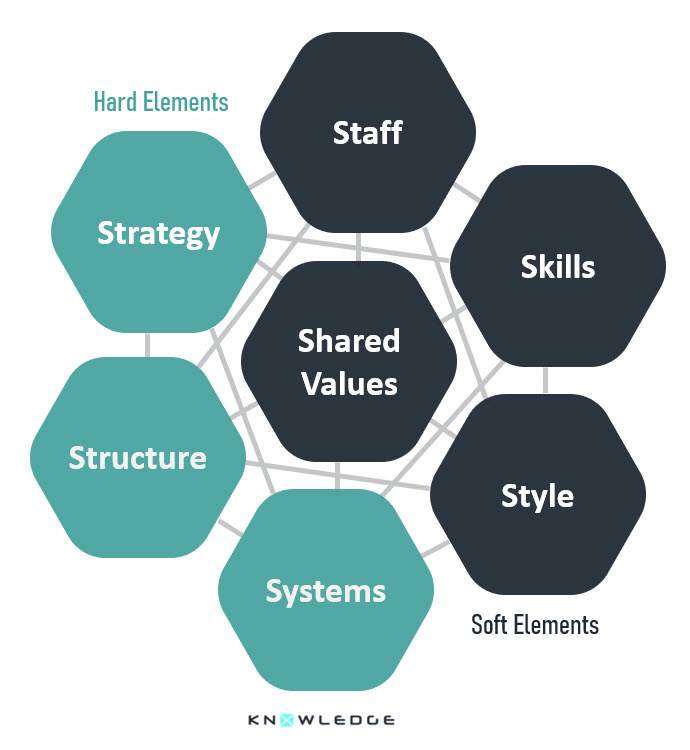The Mackinsey 7S Framework
Introduction
The Mckinsey 7S Framework is a management model developed in the 1980s by McKinsey consultants; Tom Peters, Robert Waterman Jr., and Julien Philips with the help of Richard Pascale and Anthony Athos.
The 7S framework is often used as an organisational analysis or diagnostics tool to assess and monitor changes in the internal elements of an organisation (strategy, structure, values, style, and staff) to identify what needs to be effectively aligned to improve performance and allow the organisation to achieve its objectives.
Whatever the type of change; restructuring, new processes, organisational merger, new systems, change of leadership, etc. The framework can be used to understand how the organisational elements or solutions across the organisation are interrelated.
The Mckinsey framework specified seven factors that can be classified as “hard” or “soft” elements.
Hard elements are easily identified and influenced by management, while soft elements are fuzzier, more intangible and influenced by corporate culture. The framework was called “7S” referring to the seven elements or factors that start with the letter “S” which are; Strategy, Structure, Style, Shared Values, Staff and Skills. To understand the 7S Framework better, a brief illustration can be found below.
The 7S Mckinsey Framework

Strategy
The strategic plan devised by the organisation to sustain and build a competitive advantage over the competitors in the market. Overall, an effective strategy clearly articulates a competitive advantage and must be reinforced by a clear vision, mission, and values.
Structure
It stands for the way the organisation is structured in terms of business divisions and units, this includes its current chain of command, information of who is accountable for what and reporting to whom. This structure outlines how the operations function and interconnect. This is one of the most visible and easy steps that can used to create quick changes in the other elements of the framework.
Systems
Day-to-day activities, current procedures, processes, and workflow of the company that the staff members engage in to get the job done. It is the area of the organisation that determines how the business is done and should be the core focus for managers during organisational change.
Shared Values
Also, was known as “superordinate goals” when the model was first introduced. It is the core of the Mckinsey 7S model. These are the core values of the company that are evidenced in the corporate culture and the general work ethic. In other words, the norms and standards that guide employee’s behaviour and company actions, this is the foundation of every organisation.
Style
This defines the adopted leadership styles. It represents the way the organisation or the corporate is managed by top-level managers, what management style do they adapt, how they interact with their subordinates, cascade down the actions and activities and what actions do they take and their symbolic value. How do leaders communicate changes, involve business units and managers in the discussion making process?
Staff
The include that general people of the organisation and everything related them. You need to clearly understand the manpower size, workforce demography, the currents skills, and competencies against the future needs. Understand the current talent acquisition and recruitment plans, employees’ development, training. The effectiveness of the rewards, benefits, and the levels of engagement.
Skills
The current actual skills, capabilities, and competencies of the employees to perform at high levels at the workplace. It is necessary during the organisational change planning to identify the skills and competencies that the organisation will need to reinforce in its new strategy, and have a clear plan how you are going to introduce and develop those skills to the current workforce.
The 7S Mckinsey model can work well with different types of business in all sectors and sizes. Despite saying that, it works best in medium and large businesses. One of the framework advantages is that the elements are self-explanatory and simple to apply.
Remember to manage the hard and soft elements separately;
Hard elements: Strategy, Structure and Systems.
Soft elements: Style, Skills, Staff and Shared Values.

Knowledge X says:
one of the best business analysis tools I like to use. It help you have a clear structure to the areas you need to dig into